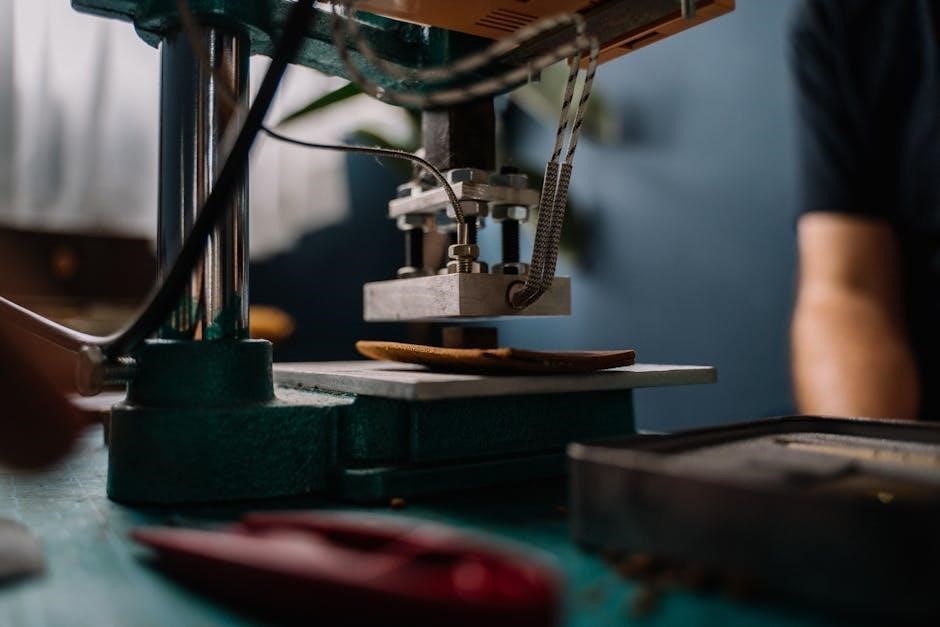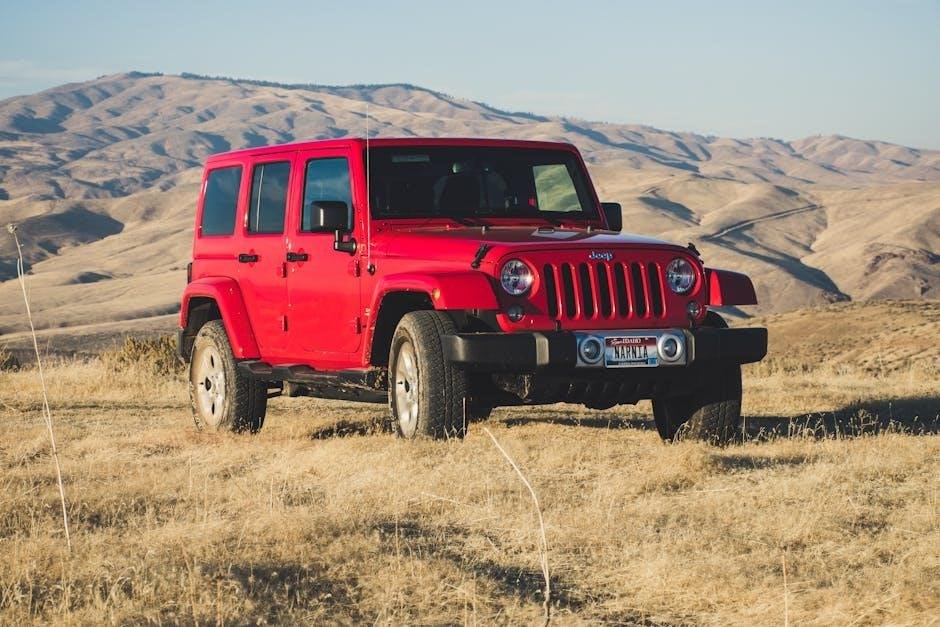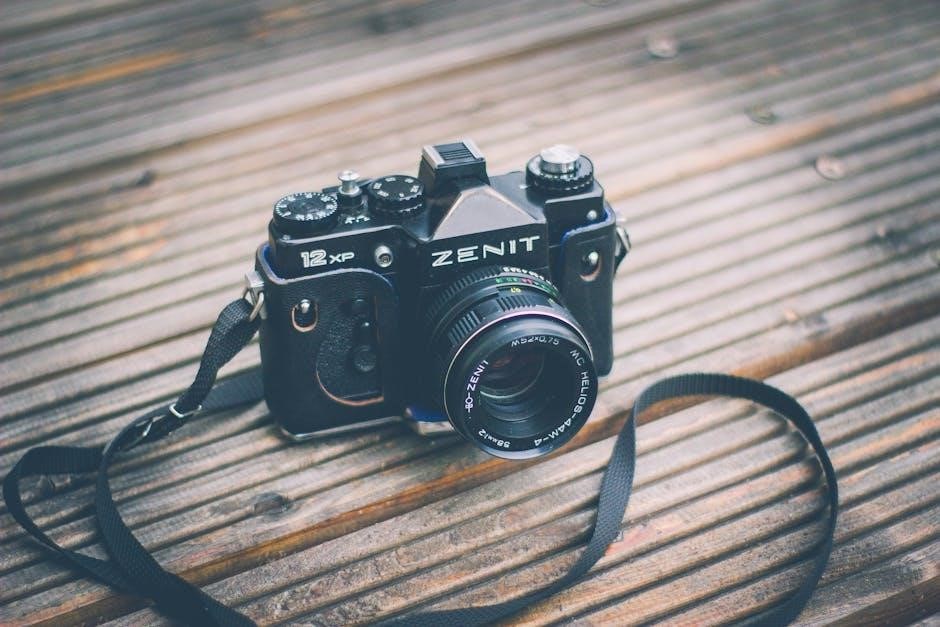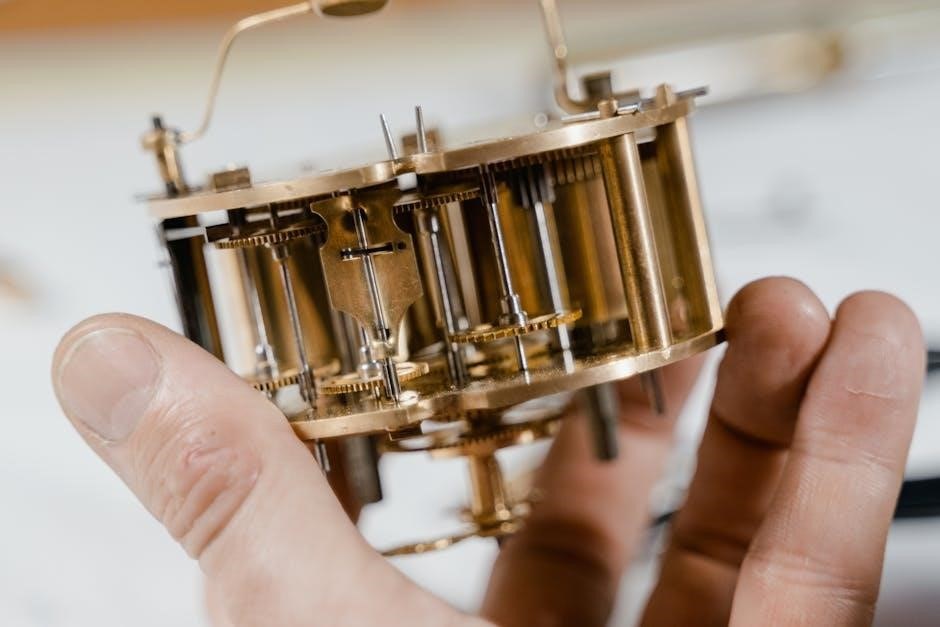jeep wrangler won’t go into gear manual
Jeep Wrangler manual transmission issues often stem from clutch, solenoid, or linkage problems, causing difficulty shifting into gear and affecting vehicle mobility, requiring prompt diagnosis and repair.
1.1 Overview of the Problem
The Jeep Wrangler’s manual transmission system may fail to engage gears due to issues like faulty shift solenoids, hydraulic leaks, or worn clutch components. Drivers often report difficulty shifting into gear, with symptoms ranging from grinding noises to complete immobility. These problems can stem from mechanical wear, fluid contamination, or electrical malfunctions within the transmission or clutch system. Addressing these issues promptly is crucial to prevent further damage and ensure safe operation of the vehicle.
1.2 Importance of Addressing the Issue
Addressing gear engagement issues in a Jeep Wrangler is critical to prevent further damage to the transmission and clutch system. Ignoring symptoms like grinding gears or difficulty shifting can lead to costly repairs, such as replacing the entire transmission or clutch assembly. Additionally, unresolved issues can compromise vehicle safety, increasing the risk of sudden failure while driving. Regular maintenance and prompt repairs ensure optimal performance, reliability, and safety on and off the road.

Common Causes of the Problem

Common causes of a Jeep Wrangler not going into gear include faulty shift solenoids, worn clutch assemblies, damaged gear shifter linkages, and internal transmission damage.
2.1 Clutch-Related Issues
A common issue is the clutch failing to disengage properly, preventing the gear from engaging. This can occur due to a worn-out clutch assembly, oil contamination, or hydraulic system leaks. Symptoms include grinding noises when shifting and difficulty moving the vehicle. If the clutch pedal feels spongy or doesn’t return fully, it may indicate a malfunction in the master or slave cylinder. Replacing the clutch assembly or bleeding the hydraulic system often resolves these problems, restoring proper gear engagement and vehicle mobility.
2.2 Faulty Gear Shifter and Linkage
A malfunctioning gear shifter or linkage can prevent the Jeep Wrangler from shifting into gear. Issues like a damaged shift cable, loose connections, or misaligned components often cause this problem. Drivers may experience difficulty moving the shifter or a lack of response when attempting to change gears. In some cases, adjusting or replacing the shifter linkage can resolve the issue, ensuring smooth and accurate gear transitions. Proper lubrication of the mechanism also helps maintain optimal performance and prevent future malfunctions.
2.3 Transmission Internal Damage
Internal transmission damage can prevent the Jeep Wrangler from engaging gears properly. Worn or damaged components like gears, bearings, or synchronizers often cause this issue. Symptoms may include grinding noises, slipping gears, or failure to shift. In severe cases, the transmission may require rebuilding or replacement. Early detection of internal wear is crucial to avoid costly repairs. Addressing these issues promptly ensures the vehicle operates smoothly and maintains its performance on both on-road and off-road terrains. Regular maintenance can help identify such problems before they escalate.
2.4 Clutch Hydraulic System Malfunction
A malfunction in the clutch hydraulic system is a common issue in manual Jeep Wranglers. Leaks in the master or slave cylinder can cause the clutch to fail to disengage properly, making it hard to shift gears. Symptoms include a soft clutch pedal, difficulty engaging gears, or the vehicle not moving when in gear. Hydraulic fluid contamination or air in the system can also disrupt clutch operation. Repairing or replacing faulty components and bleeding the system are typical solutions to restore proper functionality. Regular inspection of hydraulic lines and cylinders is recommended to prevent such issues.
2.5 Shift Solenoid Failure
A faulty shift solenoid can disrupt the Jeep Wrangler’s ability to shift gears smoothly. This electronic component controls the flow of transmission fluid, ensuring proper gear engagement. Symptoms include erratic shifting, difficulty shifting into gear, or the vehicle entering limp mode. A failed solenoid may result from electrical issues, worn internal components, or contaminated transmission fluid. Replacing the shift solenoid and checking for related system damage are essential steps to restore normal transmission operation and prevent further complications. Regular fluid changes and inspections can help prevent such failures.
2.6 Transmission Control Module (TCM) Issues
A malfunctioning Transmission Control Module (TCM) can severely affect the Jeep Wrangler’s manual transmission performance. The TCM regulates gear shifts by transmitting electrical signals to the transmission system. Issues such as software glitches, corrupted firmware, or faulty sensors can cause erratic shifting, failure to engage gears, or unexpected limp mode activation. Updating the TCM software, replacing damaged sensors, or installing a new module may be necessary to restore proper transmission functionality and ensure smooth operation. Regular diagnostic checks can help identify TCM-related problems early.

Signs and Symptoms
Common symptoms include difficulty shifting into gear, grinding noises, the vehicle not moving when in gear, and unusual clutch pedal behavior, often accompanied by dashboard warning lights.
3.1 Difficulty Shifting into Gear
Many Jeep Wrangler owners report trouble shifting into gear, especially first gear, with the shifter feeling stuck or resistant. This issue often arises after the vehicle has been stationary or during cold starts. Drivers may experience hesitation or a “catching” sensation when attempting to engage gears, which can be both frustrating and concerning. Such symptoms frequently point to problems with the clutch, shift linkage, or transmission components, requiring immediate attention to prevent further damage.
3.2 Grinding or Noisy Gears
Grinding or noisy gears during shifting are common issues in Jeep Wranglers with manual transmissions, often indicating worn synchronizers or damaged shift forks. This noise typically occurs when shifting into higher gears, especially under load. If left unaddressed, these problems can lead to costly repairs, such as replacing internal transmission components. Proper clutch engagement and avoiding aggressive shifting can help minimize wear, but professional inspection is usually necessary to resolve the issue effectively.
3.3 Vehicle Not Moving When in Gear
If your Jeep Wrangler’s manual transmission engages gear but the vehicle doesn’t move, it often points to a disengaged or worn-out clutch. This can occur due to oil contamination, excessive wear, or a faulty clutch hydraulic system. In some cases, a broken shift cable or misaligned linkage may prevent proper gear engagement. Testing the clutch pedal’s engagement and inspecting the hydraulic system are crucial first steps to diagnose the root cause and restore mobility to the vehicle effectively.
3.4 Clutch Pedal Feel and Engagement
An unusual clutch pedal feel, such as sponginess or a lack of resistance, can indicate issues like air in the hydraulic system or a failing master/slave cylinder. If the pedal engages too high or doesn’t engage at all, it may prevent proper gear shifts, leading to the vehicle not moving even when in gear. Addressing these symptoms early can prevent further damage to the clutch assembly or transmission, ensuring smooth and effective engagement of gears in your Jeep Wrangler manual transmission.
3.5 Warning Lights on the Dashboard
Warning lights on the dashboard, such as the “check engine” or “transmission” light, often indicate underlying issues preventing the Jeep Wrangler from shifting into gear. These lights may illuminate due to faulty shift solenoids, a malfunctioning transmission control module (TCM), or internal transmission damage. Modern vehicles rely on the TCM to regulate gear shifts, and errors in this system can trigger warning lights and reduce functionality. Ignoring these signals can lead to further complications, emphasizing the importance of prompt diagnosis and repair to restore proper operation.

Diagnostic Steps
Diagnosing a Jeep Wrangler manual transmission issue involves checking the clutch and hydraulic system, inspecting the shifter linkage, testing fluid levels, using a scan tool, and observing operation.
4.1 Checking the Clutch Pedal and Hydraulic System
Inspect the clutch pedal for proper operation and feel. Check the hydraulic system for leaks or damage, especially the master and slave cylinders. Test the pedal’s resistance and engagement point to ensure it disengages fully. If the pedal feels spongy or lacks resistance, it may indicate air in the system or fluid loss. Bleeding the hydraulic system can resolve issues caused by air bubbles. A malfunctioning clutch system can prevent the transmission from engaging gears properly, leading to mobility issues.
4.2 Inspecting the Gear Shifter and Linkage
Examine the gear shifter and linkage for wear, damage, or misalignment. Common issues include a broken shift cable, worn-out bushings, or loose connections. Check for smooth movement when shifting through gears. If the shifter feels loose or stuck, it may indicate a problem with the linkage or shift cable. Lubricating the shifter mechanism can resolve stiffness, while damaged components may require replacement. Proper shifter function is essential for precise gear engagement and vehicle control.
4.3 Testing the Transmission Fluid Level and Condition
Check the transmission fluid level using the dipstick, ensuring it meets the recommended level. Inspect the fluid’s color and consistency—dirty or low fluid can cause shifting issues. If the fluid is degraded or contaminated, consider replacing it. Low fluid levels may result from leaks, which should be addressed promptly. Proper fluid condition and level are crucial for smooth gear engagement and transmission performance, as insufficient or dirty fluid can lead to malfunctioning gears and shifting difficulties in your Jeep Wrangler.
4.4 Using a Scan Tool for Error Codes
Utilize an OBD-II scan tool to retrieve error codes from your Jeep Wrangler’s onboard computer. Codes related to transmission issues, such as solenoid malfunctions or sensor problems, will help pinpoint the root cause. For manual transmissions, codes may indicate clutch position sensor faults, shift solenoid failures, or TCM-related issues. This diagnostic step provides precise information, guiding repairs and ensuring the problem is addressed effectively without unnecessary guesswork or additional damage to the vehicle.
4.5 Observing the Vehicle’s Behavior During Operation
Observe your Jeep Wrangler’s behavior while driving to identify specific symptoms. Note if gears hesitate to engage, grind, or feel sticky. Test in different conditions, such as accelerating uphill or shifting into reverse. Pay attention to unusual noises or vibrations during gear shifts. Check if the issue persists across all gears or is isolated to specific ones. This hands-on evaluation helps pinpoint whether the problem is mechanical, hydraulic, or electronic, guiding further diagnostic steps and repairs effectively.

Clutch-Related Repairs
Clutch-related issues often require replacing the clutch assembly, bleeding the hydraulic system, or adjusting the clutch pedal to restore proper gear engagement and smooth operation.
5.1 Replacing the Clutch Assembly
Replacing the clutch assembly is a common repair for Jeep Wranglers with manual transmissions. A worn or contaminated clutch can prevent proper gear engagement, causing the vehicle to fail to move when in gear. The process involves removing the old clutch and installing a new one, ensuring the flywheel is resurfaced if necessary. Proper alignment and secure bolting are crucial for optimal performance. This repair typically resolves issues where the clutch fails to engage or disengage smoothly.
5.2 Bleeding the Clutch Hydraulic System
Bleeding the clutch hydraulic system is essential to remove air bubbles that can cause a spongy clutch pedal or failure to engage gears. Using a clutch bleeding kit, start by pumping the pedal to pressurize the system, then release slowly. Repeat the process until fluid flows freely without bubbles. Ensure the master and slave cylinders are functioning properly, as any leaks or damage can prevent proper clutch engagement. This procedure often resolves issues where the clutch feels unresponsive or inconsistent, especially after clutch assembly replacement.
5.3 Adjusting the Clutch Pedal
Adjusting the clutch pedal ensures proper engagement and disengagement of the clutch. Begin by locating the adjustment nut on the pedal or master cylinder. Turn the nut to set the free play, ensuring the pedal has a slight gap when released. Next, adjust the pedal height to meet the driver’s comfort while maintaining proper engagement. Test the clutch by shifting gears to confirm smooth operation; Proper adjustment prevents issues like delayed engagement or clutch slippage, ensuring optimal performance and longevity of the system.

Gear Shifter and Linkage Repairs
Repairs often involve replacing the shift cable or adjusting the shifter linkage. Lubricating the mechanism and ensuring proper alignment can resolve issues with gear engagement and smooth shifting.
6.1 Replacing the Shift Cable
Replacing the shift cable is a common fix for gear-shifting issues in Jeep Wranglers. If the cable is damaged, worn, or misaligned, it can prevent proper gear engagement. Start by inspecting the cable for signs of wear or corrosion. If damaged, purchase a replacement cable compatible with your Jeep’s manual transmission. Disconnect the old cable from the transmission and shifter, then install the new one, ensuring it’s securely attached. Proper alignment and adjustment are crucial for smooth shifting. After installation, test the gears to confirm the issue is resolved. Regular lubrication of the shifter mechanism can also help maintain functionality and prevent future problems.
6.2 Adjusting or Replacing the Shifter Linkage
If the shifter linkage is loose, misaligned, or damaged, it can prevent proper gear engagement. Inspect the linkage for wear or damage. If adjustment is needed, loosen the bolts, realign the linkage, and tighten securely. If damaged, replace the linkage with a genuine part. Ensure the shifter operates smoothly and gears engage correctly after adjustment or replacement. Proper alignment is crucial for accurate shifting. Lubricating the linkage can also improve functionality and extend its lifespan. Regular checks can prevent future shifting issues.
6.3 Lubricating the Shifter Mechanism
Lubricating the shifter mechanism can resolve stiffness and improve shifting smoothness. Use silicone-based spray or lithium grease on pivot points and bushings. Clean the area first to ensure proper adhesion. Apply lubricant evenly, then wipe off excess. Regular lubrication prevents corrosion and wear, ensuring consistent performance. This maintenance step is crucial for longevity and can address minor issues before they escalate. Keep the shifter mechanism well-lubricated to maintain precise gear engagement and smooth operation.

Transmission Repairs
Transmission repairs often involve rebuilding or replacing damaged components like shift forks, synchronizers, or internal gears. Addressing internal damage promptly prevents further wear and ensures smooth operation.
7.1 Rebuilding or Replacing the Transmission
Rebuilding or replacing the transmission is a significant repair for resolving gear issues in a Jeep Wrangler. If internal damage is extensive, a full replacement may be necessary. However, in cases of minor wear, rebuilding the transmission with new bearings, seals, and gaskets can restore functionality. This process involves disassembling the unit, inspecting components like shift forks and synchronizers, and replacing any damaged parts. Rebuilding is cost-effective and often sufficient, but severe damage may require a factory-rebuilt or new transmission for reliability.
7.2 Replacing Worn Synchronizers
Worn synchronizers are a common cause of gear-shifting difficulties in manual transmissions. Synchronizers facilitate smooth gear transitions by equalizing the speed of the gear and shaft. When worn, they can cause grinding or hesitation between gears. Replacing them involves removing the transmission, inspecting synchronizer rings, and installing new ones. This repair is critical to restore proper gear engagement and prevent further transmission damage. While complex, it’s essential for maintaining smooth operation and preventing costly future repairs.
7.3 Fixing Damaged Shift Forks
Shift forks are critical components that engage gears within the transmission. Damage to these forks can prevent gears from meshing properly, leading to grinding or failure to shift. Repairing shift forks typically requires disassembling the transmission to inspect and replace damaged parts. Worn or bent forks must be replaced to restore proper gear engagement. This repair is labor-intensive but essential to ensure smooth shifting and prevent further transmission damage. Proper alignment and reassembly are crucial for optimal performance.

Shift Solenoid and TCM Repairs
Shift solenoid failure can cause limp mode, requiring replacement. Updating or replacing the TCM ensures proper transmission control. Resetting the TCM post-repair restores optimal shifting functionality.
8.1 Replacing the Faulty Shift Solenoid
Replacing a faulty shift solenoid involves removing the transmission pan and disconnecting electrical connectors. Install the new solenoid, ensuring proper alignment and torque specs. Refill transmission fluid and test shifting. This repair often resolves limp mode and gear engagement issues, restoring smooth transmission operation.
8.2 Updating or Replacing the Transmission Control Module
Updating or replacing the Transmission Control Module (TCM) is essential if it’s malfunctioning. Start by downloading the latest software using a compatible scan tool. If the TCM is damaged, install a new unit and ensure it’s properly calibrated. Reset the system and test the transmission’s performance. This process often resolves issues like erratic shifting or limp mode, ensuring smooth gear transitions and optimal vehicle performance. Professional assistance is recommended for accurate calibration and troubleshooting.
8.3 Resetting the TCM After Repairs
After replacing or updating the TCM, resetting it is crucial for proper transmission function. Disconnect the battery for 10-15 minutes to reset the system. Reconnect and test drive the vehicle, allowing the TCM to relearn shifting patterns. Use a scan tool to clear error codes and ensure the transmission operates smoothly. If issues persist, consult a professional to verify the TCM’s calibration. Proper resetting ensures optimal gear engagement and prevents further transmission problems, restoring your Jeep Wrangler’s performance effectively.

Preventative Maintenance
Regular maintenance is key to preventing gear issues in your Jeep Wrangler. Schedule transmission fluid changes, inspect the clutch and hydraulic system, and lubricate the shifter mechanism.
9.1 Regular Transmission Fluid Changes
Regularly changing the transmission fluid in your Jeep Wrangler is essential for maintaining smooth gear transitions. Over time, fluid can degrade, leading to increased wear on internal components and potential shifting issues. It is recommended to replace the fluid every 30,000 to 60,000 miles, depending on driving conditions. Use the specified type of fluid to ensure optimal performance and longevity of your manual transmission system.
9.2 Inspecting the Clutch and Hydraulic System
Inspecting the clutch and hydraulic system is crucial for maintaining smooth gear engagement. Check for signs of hydraulic fluid leaks, worn clutch components, or air in the system. Ensure the clutch pedal operates smoothly and fully disengages. Test the slave cylinder for proper function, as a faulty one can prevent the clutch from disengaging. Regular inspections can identify issues early, preventing costly repairs and ensuring reliable shifting in your Jeep Wrangler’s manual transmission.
9.3 Lubricating the Shifter and Linkage
Lubricating the shifter and linkage ensures smooth gear transitions and prevents mechanical wear. Use a silicone-based spray or lithium grease on pivot points and joints. Clean the area first to remove dirt and old lubricant. Apply the lubricant evenly, focusing on moving parts like the shift cable ends and linkage connections. Regular lubrication helps maintain precise shifting and reduces the risk of stiffness or corrosion, keeping your Jeep Wrangler’s manual transmission system operating reliably over time.
9.4 Avoiding Aggressive Driving Habits
Avoiding aggressive driving habits is crucial for maintaining your Jeep Wrangler’s manual transmission. Rapid shifting, riding the clutch, and sudden acceleration can strain the transmission and clutch, leading to premature wear. Instead, use smooth, deliberate shifts and avoid revving the engine excessively. Refrain from resting your foot on the clutch pedal while driving, as this can wear out the pressure plate and release bearing. Gentle driving habits help preserve the longevity of your transmission and clutch system, ensuring reliable performance over time.
Addressing gear shifting issues in your Jeep Wrangler requires prompt attention to the clutch, transmission, and solenoid systems. Regular maintenance and avoiding aggressive driving habits ensure longevity and optimal performance.
10.1 Summary of Key Points
10.2 Final Thoughts on Maintaining Your Jeep Wrangler
Regular maintenance is key to preventing issues like difficulty shifting gears. Check transmission fluid levels, inspect the clutch and hydraulic system, and lubricate the shifter mechanism. Addressing symptoms early, such as warning lights or noisy gears, can prevent costly repairs. Avoid aggressive driving habits and ensure proper engagement of gears. By following these steps, you can extend the life of your Jeep Wrangler’s transmission and enjoy smooth, reliable performance for years to come.
